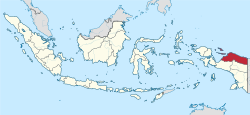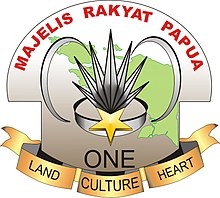Papua | |
|---|---|
| Province of Papua Provinsi Papua | |
| Nickname(s): | |
| Motto(s): | |
 | |
| Coordinates(Jayapura): 2°32′S140°43′E / 2.533°S 140.717°E | |
| Country | |
| Establishment | 27 December 1949 [1] |
| Indonesian administration | 1 May 1963 [2] |
| Latest partition | 30 June 2022 [3] |
| Capital and largest city | Jayapura |
| Divisions | 8 regencies and 1 city |
| Government | |
| • Body | Papua Provincial Government |
| • Governor | Ramses Limbong (acting) |
| • Vice Governor | Vacant |
| Area | |
• Total | 82,680.95 km2 (31,923.29 sq mi) |
| • Rank | 7th in Indonesia |
| Population (mid 2024 estimation) [5] | |
• Total | 1,060,550 |
| • Density | 13/km2 (33/sq mi) |
| Time zone | UTC+09:00 (Indonesia Eastern Time) |
| ISO 3166 code | ID-PA |
| Vehicle registration | PA |
| HDI (2024) | |
| Website | papua |
Papua is a province of Indonesia, comprising the northern coast of Western New Guinea together with island groups in Cenderawasih Bay to the west. It roughly follows the borders of Papuan customary region of Tabi Saireri, [7] [8] and is divided into eight regencies (kabupaten) and one city (kota), the latter being the provincial capital of Jayapura.
Contents
- Politics
- Government
- Administrative divisions
- Geography
- Demographics
- Religion
- See also
- References
- Cited works
- External links
It is bordered by nation of Papua New Guinea to the east, the Pacific Ocean to the north, Cenderawasih Bay to the west, and the provinces of Central Papua and Highland Papua to the south. The province also shares maritime boundaries with Palau in the Pacific. Papua, along with the five other Papuan provinces,[ citation needed ] has a higher degree of autonomy level compared to other Indonesian provinces. [9]
Prior to 2003, the province (known as Irian Barat from 1962 to 1973 and Irian Jaya from 1973 to 2002) covered the entirety of Western New Guinea, a region also known as "Papua". In 2002, Papua adopted its current name and was granted a special autonomous status under Indonesian legislation. In 2001, the western end of the province was split off into a new province of West Papua, and in July 2022 the provinces of Central Papua, Highland Papua, and South Papua were also split off, leaving the current province covering a much smaller northern area around Jayapura, the northern part of the former province, and the islands in the Cenderawasih Bay.
The official estimate of the population in mid 2024 of the province under its current borders was 1,060,550 (comprising 554,800 males and 505,800 females). [5]




